We may not have the course you’re looking for. If you enquire or give us a call on +352 8002-6867 and speak to our training experts, we may still be able to help with your training requirements.
Training Outcomes Within Your Budget!
We ensure quality, budget-alignment, and timely delivery by our expert instructors.
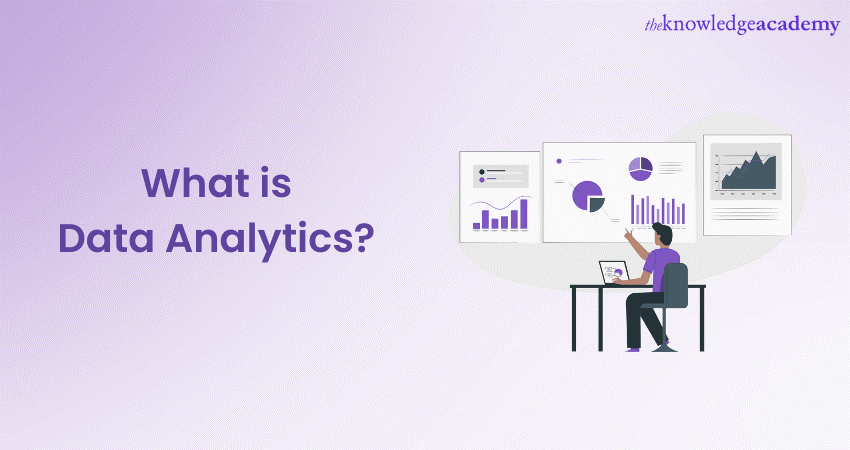
In today’s digital age, data has become an invaluable asset for businesses, organisations and individuals. This is because they are in constant search of result-driven decision-making. The sheer amount of data generated daily is staggering, and its potential to transform decision-making and drive innovation is unprecedented. However, raw data is just the beginning; to harness its true power, we need to delve into the realm of Data Analytics. This blog will explore What is Data Analytics actually, its process, types, advantages and disadvantages, and the vital role it plays in shaping our data-driven world.
Analytics has much more potential than we think; companies often keep data to help them plan out their strategy regarding resource management and allocation of resources. Many tech and gaming companies nowadays use customer data to create more engaging content. So, let's learn What is Data Analytics- The process of converting raw data into meaningful information is known as Data Analytics. Read more!
Table of Contents
1) What is Data Analytics?
2) Importance of Data Analytics
3) Process of Data Analytics
4) Types of Data Analytics
5) Advantages of Data Analytics
6) Disadvantages of Data Analytics
7) Future of Data Analytics
8) Conclusion
What is Data Analytics?
Data Analytics is a process of examining, cleaning, transforming, and interpreting data to extract meaningful insights, patterns, and trends. It involves a systematic approach to examining data sets, utilising statistical and computational techniques to reveal hidden relationships and draw valuable conclusions. Data Analytics serves as the bridge between raw data and actionable information, helping individuals and organisations make informed decisions, predict future outcomes, and solve complex problems.
Data analysts, on the other hand, use this data to solve bigger problems that are impossible or more complex for the human mind. Analytics helps in business optimisation, increasing profit and grabbing more market share for the organisation if performed strategically with trained professionals. Data Analytics can support a company's attempts to boost customer service, optimise marketing campaigns, and generate revenue. Analytics, on the other hand, give companies the ability to react swiftly to changes according to market trends and acquire an edge over rival companies.
Importance of Data Analytics
Importance of Data Analytics is on the rise for enterprises. Through the discovery of more efficient business methods and the retention of extensive data, companies can strategically reduce costs. Moreover, organisations can leverage Data Analytics to enhance decision-making processes, monitor consumer preferences and trends, and innovate better products and services, thereby creating new avenues for business growth.
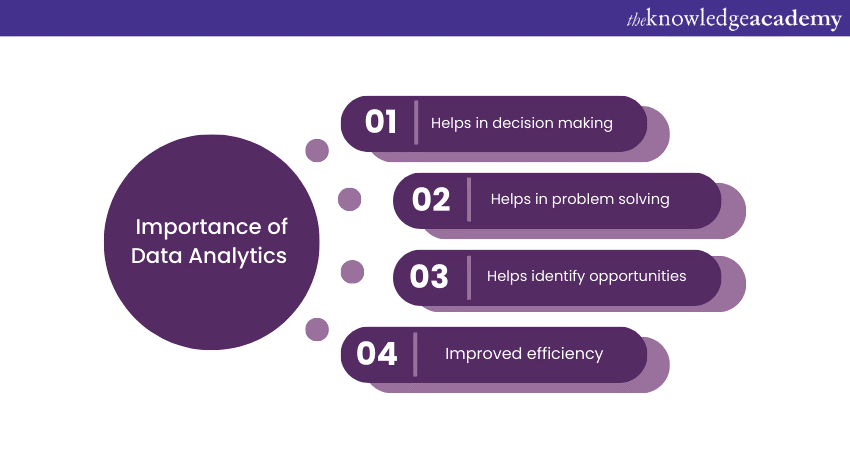
Decision making
Data-driven decision-making is becoming increasingly crucial for businesses. By analysing historical and real-time data, organisations can identify trends and patterns, helping them make strategic choices that lead to higher efficiency, profitability, and growth. Executives may also enable their organisations to be more proactive in seeing opportunities by using a data-driven decision-making model because they can base their decisions on the validity of data rather than just gut instinct or previous experience in the field.
Problem solving
Data Analytics enables problem-solving on a deeper level. By exploring data sets, researchers and analysts can identify the root causes of issues and devise targeted solutions for a wide array of challenges. It's also critical that decision-makers recognise that while data may reveal a pattern or point to a particular result, a mistake in the analysis or collection method might possibly make it unreliable or deceptive while solving a problem.
Identify opportunities
Data Analytics helps identify untapped opportunities and market trends. By understanding customer behaviour and preferences, businesses can tailor their offerings to meet evolving demands, gaining a competitive edge in the market. Organisations can alter their current products or services to meet shifting consumer wants, adjust marketing strategies, and improve customer experiences thanks to insights from Data Analytics. Data analysis can improve agility and make the difference between a corporation succeeding and failing by a very small margin.
Improved efficiency
Analysing operational data allows businesses to optimise processes and streamline workflows. Identifying bottlenecks and inefficiencies empowers organisations to make data-driven adjustments and enhance overall productivity. For instance, Businesses can discover valuable trends to improve their goods and services by gathering a lot of client feedback and data.
Process of Data Analytics
It's time to focus on the Data Analytics process itself. The five primary actions a data analyst will take when starting a new project or a business for informed decision-making are described below:
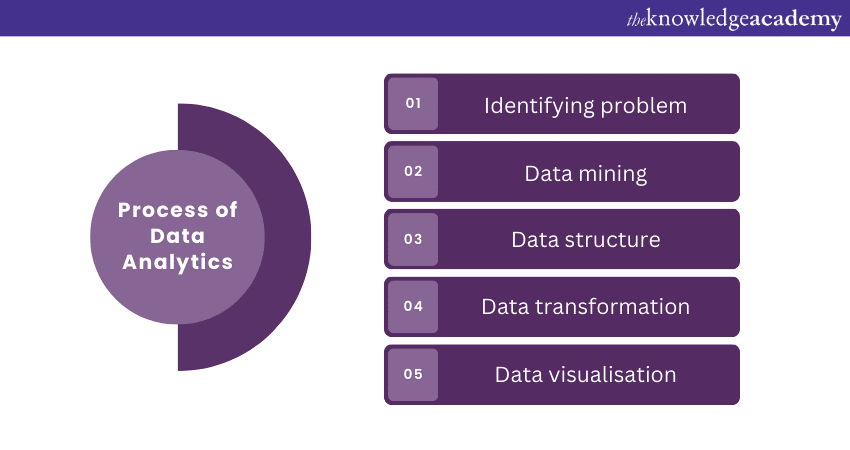
Identifying problem
The first step in Data Analytics is to clearly define the problem or objective. This involves understanding what information is required, what questions need to be answered, and what insights will add value. This is the foundation of the entire Data Analytics process. Identifying the problem rightly is like identifying the pain point of the business.
Register for our Data Analytics For Project Managers Training to attain in-depth knowledge of Data Analytics!
Data mining
Data mining helps discover patterns and relationships in large datasets to extract valuable knowledge. It is often used in areas like marketing, fraud detection, and recommendation systems. Once the problem is identified, the next step is to gather relevant data with the help of data mining. There is a slight difference between Data mining and Data Analytics
Data can be collected from various sources, such as surveys, sensors, Big Data databases, and web scraping, depending on the scope and nature of the analytics. The accuracy of data mining is largely dependent on the sample size of the data collected.
Data structure
Raw data is seldom perfect. It often contains errors, missing values, or inconsistencies. Data structuring involves detecting and rectifying these issues to ensure the accuracy and reliability of the analytics. These findings must be interpreted in the context of the problem statement to derive actionable recommendations. Data structuring, in other words, can help remove clusters and provide clear pieces of information, resulting in improved decision-making.
Data transformation
Data transformation involves converting data into a suitable format for analytics. This may include aggregating, normalising, or encoding data, depending on the specific requirements. Various techniques are employed during Data Analytics, including descriptive statistics, inferential statistics, Machine Learning, and data mining. These methods help uncover patterns, relationships, and insights within the data.
Data Visualisation
Data Analytics and Visualisation go hand in hand and are an integral part of Data Analytics. It enables the presentation of complex information in a visually appealing and easily understandable manner, aiding stakeholders in grasping the key takeaways. Data visualisation is an essential step to gain an understanding of the data in a much better sense. This includes summary statistics, graphic visualisation, and exploring relationships between variables.
Types of Data Analytics
Various types of Data Analytics can be segmented into four basic types. Let's examine the four primary categories of Data Analytics: descriptive, diagnostic, predictive, and prescriptive now that we have a workable definition of Data Analytics.
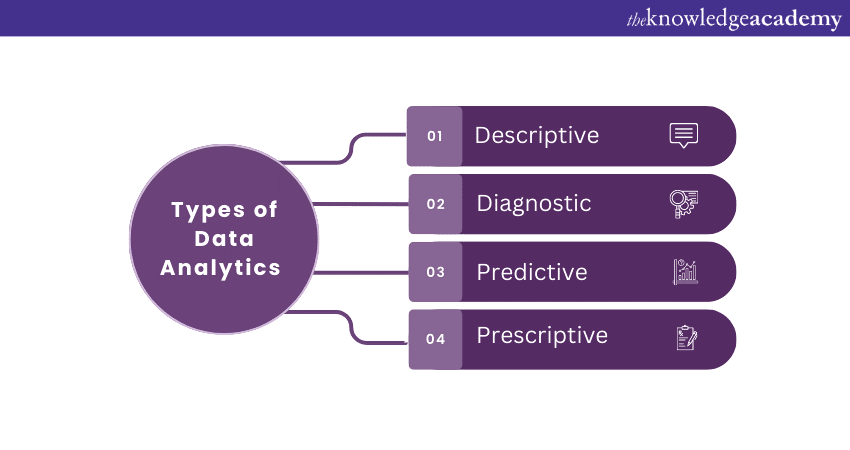
Descriptive
Descriptive statistics summarise and describe the main features of a dataset. Measures such as mean, median, mode, variance, and standard deviation provide a snapshot of the data's central tendencies and spread. This basically helps to determine “what” needs to be done. The whole idea of descriptive statistics is used in statistical analytics at this stage.
Diagnostic
Diagnostic analytics emphasises mainly the “why” factor. This stage demands a large number of data to go through the system to analyse all the possibilities underlying to unleash new business opportunities. For instance, a company may undergo diagnostic analytics to analyse the sudden drop in sales despite its competitors doing well.
Predictive
By applying predictive analytics, businesses can forecast future trends and behaviours. This foresight enables them to address potential issues and capitalise on upcoming opportunities. Predictive analytics calculates the historical data and probability theory in making important business choices.
With the help of predictive analytics, it is possible to predict a wide range of outcomes, from the product that will be most in demand at a given time to the expected growth or decline of a company’s growth or revenue over a particular time frame.
Prescriptive
One of the difficult types of analytics is prescriptive analytics, which might require working with algorithms, machine learning, and computational modelling techniques. However, a company's ability to employ prescriptive analytics effectively can significantly impact how it makes decisions.
Prescriptive analytics demonstrates how to benefit from the results that have been forecast. Data analysts will evaluate many potential outcomes when conducting prescriptive analytics before taking a call to action.
Advantages of Data Analytics
Data Analytics may assist a company with everything from tailoring a long-term marketing goal to a specific client need to recognise and reduce business hazards. Let's dive into these four Advantages of Data Analytics.
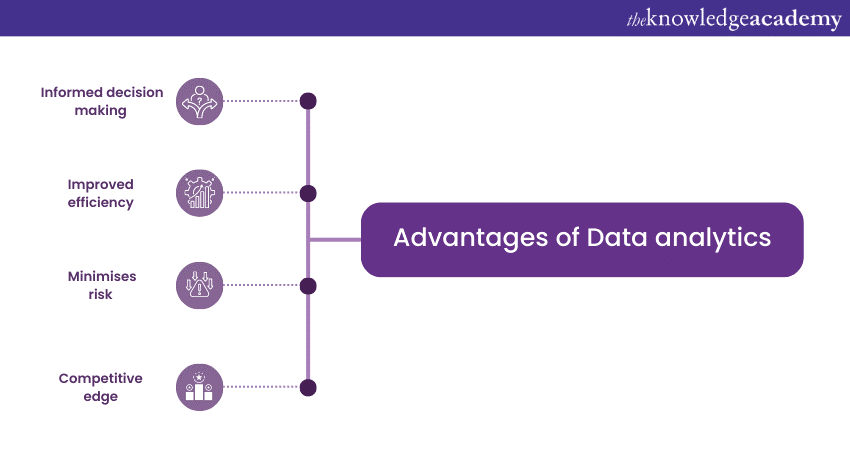
Informed decision-making: Organisations can optimise their strategy and make better decisions, which leads to productivity, cost-effectiveness, exploration of new opportunities, and lower risks. Data Analytics also enables organisations to make transparent and reliable judgements because they are based on real-world scenarios.
Improved efficiency: Data Analytics can help organisations increase operational effectiveness. For instance, a supply chain can reveal the source of production delays and prevent itself from any future issues with inventory management and distribution network optimisation.
Minimises risk: Data from diversified sources might reveal patterns and connections that hint at possible business threats. Data analysis can help businesses spot potential fraud, IT threats or any other problem that can hamper day-to-day operational work. They can reduce the likelihood of financial and accountability issues by creating a risk-free ecosystem.
Competitive edge: Detailed analytics can help businesses hone their tactics, identify fresh chances, and differentiate themselves from the competition. For instance, Data Analytics can help businesses find untapped market areas, anticipate client needs and improve their product quality. Companies can gain competitive advantages, boost revenue growth, and expand their market share.
Disadvantages of Data Analytics
While Data Analytics is a powerful tool, it is not without its challenges and limitations:
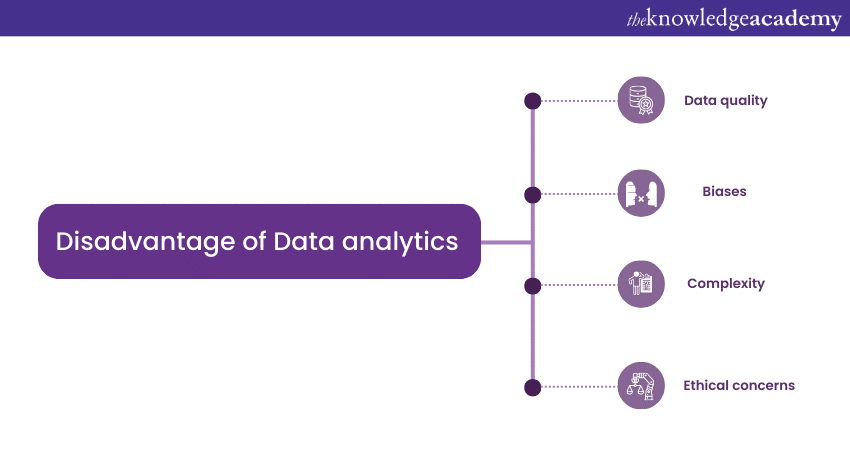
Data quality: There is an abundance of data in organisations. But how much of this information is reliable is still a question mark. In some cases, the necessary data may not be there or maybe lacking for meaningful analytics to be performed. Poor data quality which may lead to inaccurate conclusions. Data cleaning is vital to ensure the integrity of the analytics.
Biases: Data may be subject to inherent biases, which can impact the objectivity of the analytics. Recognising and addressing biases is crucial because of the logic that goes into consideration. No one inside the organisation can explain the reasoning behind how decisions are made.
Complexity: Analysing massive datasets can be computationally intensive and time-consuming. Specialised tools and technologies are required to handle big data efficiently. Analytics models require a commitment to deploy the solution and increase accuracy; businesses should not instantly perceive outcomes. Also, certain Data Analytics technologies are difficult to use and call for training. This raises the price for businesses using Data Analytics Tools or technologies.
Ethical concerns: The use of data raises ethical questions, especially regarding privacy, consent, and the potential for misuse. Therefore, businesses need to be careful about the type of data they gather, be it customer data or any other data for that matter and protect the privacy and security of the data to avoid any compliance issues. Businesses gather customer information to analyse it and improve business decisions. However, this can result in a violation of the consumer's anonymity.
What are some real-world Data Analytics examples?
Things become easier with real-life examples. So, let’s have a look at them:
1) A Data Analytics case study: Healthcare sector
An area where Data Analytics is leaving great impact is the healthcare sector. A researcher from the University of Delaware, Junbo Son, currently an assistant professor, specialised on Data Analytics, Operations Management and Quality and Reliability. He devised a system that helps asthma patients. The system assists in a better self-management using Bluetooth-powered inhalers and a special Data Analytics algorithm alongside the device.
So how does this function? Firstly, the data is collected through a Bluetooth sensor. This is done when the user attaches to their asthma inhaler. Every time the inhaler is being used; the sensor transmits this usage data to their smartphone. The data is then sent to the server via secure and wireless network. There it goes through the specially devised Smart Asthma Management (SAM) algorithm.
Over the time, the unique algorithm helps to project each individual patient’s pattern. It provides valuable insight into patient demographics and unique patient behaviours. For example, when they tend to exercise, how that might have impacted their inhaler usage. Along with that it also tracks each patient’s separate sensitivity to environmental asthma triggers.
This is useful especially when it comes down to inspecting dangerous increases in inhaler usage. The data-driven SAM system can identify these increases way faster than the patient would be able to manually. It was observed that the SAM system has been found to outperform traditional models. The false alarm rate that is 10-20% lower than that of current models, together with a 40-50% lower misdetection rate.
By collecting and analysing the right data, healthcare professionals can offer support that is tailored to both the individual needs of each patient and the unique characteristics of different health conditions.
2) A Data Analytics case study: Netflix
This case study covers something you are extremely familiar with. Ever thought how Netflix provides you with the personalised viewing recommendations? What impact does this feature have on the success of the business?
The entire process starts with data collection. Netflix collects all kinds of data from its 163 million global subscribers. This includes various factors. Such as what its users watch and when, what device they use. It also inspects if they pause or resume it, and how they rate contents. Another important element that determines the collection process is monitoring search when looking for something new to watch.
With the help of Data Analytics, Netflix can connect all individual data points to create a personalised viewing profile for each user. Based on key trends and patterns within each user’s viewing behaviour, the recommendation algorithm makes suggestions.
What's the difference between Data Analytics and Data Science?
There are two major differences that sets Data Analytics apart from Data Science. These distinctions highlight the broader, and complex features. Let’s have a look at them:
|
Key difference |
Data Analytics |
Data Science |
|
Data usage |
Primarily deals with structured data in well-organised databases. It relies on more traditional statistical methods for analysis. |
Deals with larger and more complex datasets. It is often involved in unstructured data from various sources. |
|
Skills and tools |
Focuses on descriptive and inferential statistics. It is to explore and summarise data, using tools like Excel and SQL for data manipulation and visualisation. |
Uses a wide range of techniques including machine learning, natural language processing, and network analysis. Data scientists often develop custom algorithms and models to extract insights from data. |
Register for our Probability and Statistics for Data Science Course to gain an in-depth knowledge about Data Science and stats!
Skills needed to be successful in Data Analytics
There are certain skills that will help you kick-start a career in Data Analytics! A combination of both the soft and hard skills can provide the necessary blend to be successful in this domain. Here are the important skills listed below:
Technical skills:
1) Have a strong grip on data processes and principles
2) Ability to apply statistical methods
3) Understanding about machine learning algorithms and models
4) Thorough knowledge about programming languages
5) Predictive modelling
6) Database Management
7) Proper knowledge about governance and quality checks throughout complete data life cycle
Soft skills:
1) Presentation skills and storytelling capabilities
2) Problem-solving
3) Analytical and creative thinking
4) Decision making capacity
5) Time management
Understand the importance of data visualisation with our Data Analysis And Visualisation With Python Course – join today!
What are some common challenges in Data Management?
Some common challenges in Data Management are:
1) Integrating multiple datasets
2) Managing newer data formats
3) Dealing with data related skill issues
4) Dealing with data regulations
5) Building proper networking architecture
6) Lack of automation in data processes
7) Building proper storage architecture
8) Dealing with data silos
What is the role of Data Analytics?
Data Analysts work at the intersecting point of information technology, statistics and business. They combine features of these fields to help businesses and organisations find success. A major goal is to increase efficiency and improve performance by discovering patterns in data.
The work of a Data Analyst includes working with data throughout the Data Analysis pipeline. The primary steps in the Data Analytics process are data mining, Data Management, statistical analysis and data presentation. The balance of these steps depends on the data being used and the goal of the analysis.
Statistical analysis allows analysts to find insights within data. Both statistics and machine learning techniques are used to analyse data and create statistical models that reveal trends. These models can then be applied to new data to make predictions and inform decision making. Statistical programming languages such as R or Python (with pandas) are essential to this process. In addition, open-source libraries and packages such as TensorFlow enable advanced analysis.
The final step in many Data Analytics processes is data presentation. This step prepares insights to be shared with stakeholders. Data Visualisation is an important tool in this step. Compelling visualisations can help tell the story of data, which may help executives and managers understand the importance of these insights.
Future of Data Analytics
Data analysts and scientists are now becoming more experimental to extract more business penetration ideas as technology advances. With Technological advances data analytics and data visualisation will play a significant role in businesses across sectors. Data analysis will continue to evolve with flying colours:
Artificial Intelligence: AI-powered data analysis will lead to more sophisticated and accurate predictions, enabling better decision-making. For instance, in fields like manufacturing and healthcare, where intelligent systems monitor components like robotics, Data Analytics and Machine Learning (ML) and artificial intelligence (AI) are already being successfully applied.
Businesses might ultimately gain incredible results from AI systems by creating effective and efficient operations. A strong AI system can secure sensitive data, be quicker, be more adaptive, and offer a greater return on investment. For instance, an automobile manufacturing assembly line may be automatically diverted to another location when a part is on the verge of failing.
Real-time Analysis: Real-time data analysis will become more prevalent, allowing businesses to react promptly to changing conditions. This will lead to more informed decision-making, improve data quality and give real-world insight. Business users and executives can ask pertinent inquiries and discover insights more quickly with the aid of an augmented analytics solution.
Additionally, even if they lack in-depth analytical experience, sophisticated users and analysts can undertake more thorough analysis and data preparation duties with the aid of real-time analytics. For instance, stock market data can be analysed more potentially to outperform even in the recession phase cycle.
Internet of Things: The application of IoT devices will generate vast amounts of data, necessitating advanced data analysis techniques. The benefits for enterprises and individuals are growing as IoT and big data grow, influencing all business and technology areas.
The big data environment has been significantly impacted by the growing amount of data produced by IoT systems, especially social media, which has the potential to enhance the functionality of current connected devices.
Keen to crack your interviews for data analytics roles, refer to our blog on "Data Analytics Interview Questions"
Conclusion
Data analytics is a cornerstone of our data-driven world. It empowers businesses, organisations, and individuals to unlock valuable insights, enabling informed decisions and innovative solutions. From the advent of AI to the rise of IoT, data analysis will remain at the forefront of technological progress, shaping the future of how we interact with and understand the world around us. As we embrace this data-driven era, data analysis will continue to drive progress, enrich our lives, and revolutionise how we perceive and interpret information.
Learn more about Data Analytics with our Data Analytics For Project Managers Training – join now!
Frequently Asked Questions

The answer is yes. As a Data Analyst, you need to have coding skills in programming languages.

A career in Data Analysis is both lucrative and satisfactory. You get to a part of crucial projects and the salary structure is also high.

The Knowledge Academy takes global learning to new heights, offering over 30,000 online courses across 490+ locations in 220 countries. This expansive reach ensures accessibility and convenience for learners worldwide.
Alongside our diverse Online Course Catalogue, encompassing 17 major categories, we go the extra mile by providing a plethora of free educational Online Resources like News updates, Blogs, videos, webinars, and interview questions. Tailoring learning experiences further, professionals can maximise value with customisable Course Bundles of TKA.

The Knowledge Academy’s Knowledge Pass, a prepaid voucher, adds another layer of flexibility, allowing course bookings over a 12-month period. Join us on a journey where education knows no bounds.

The Knowledge Academy offers various Big Data and Analytics Courses, including Advanced Data Analytics Training, Advanced Data Science Training, Big Data Analysis Training, and Data Science and Blockchain Training. These courses cater to different skill levels, providing comprehensive insights into Data.
Our Data, Analytics & AI Blogs cover a range of topics related to Data Analytics offering valuable resources, best practices, and industry insights. Whether you are a beginner or looking to advance your Data Analyticsskills, The Knowledge Academy's diverse courses and informative blogs have you covered.







 Top Rated Course
Top Rated Course




 If you wish to make any changes to your course, please
If you wish to make any changes to your course, please


